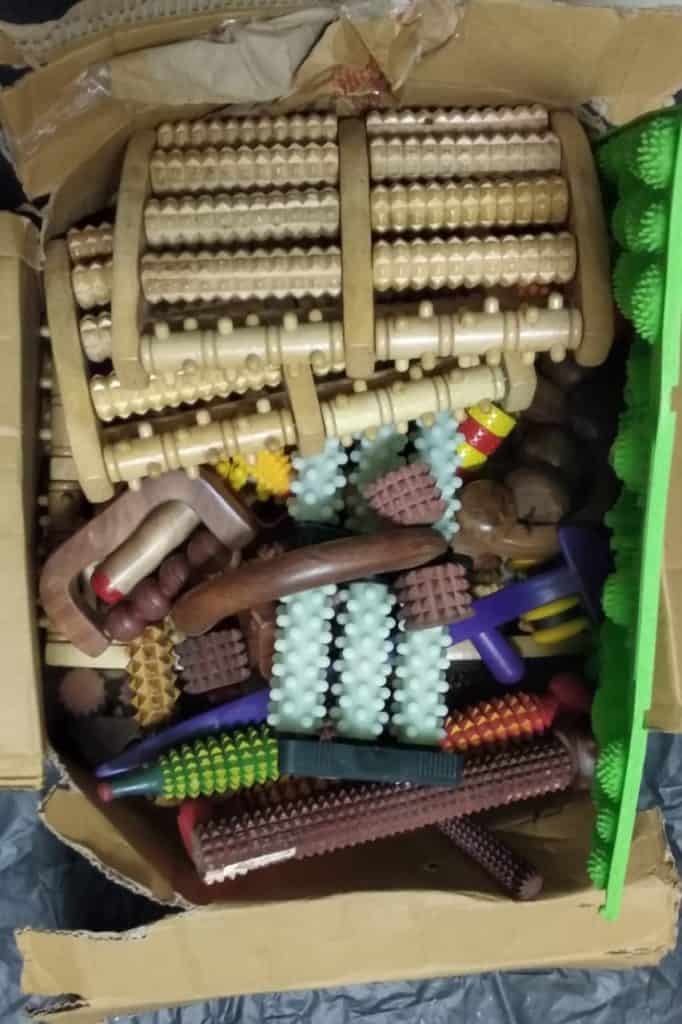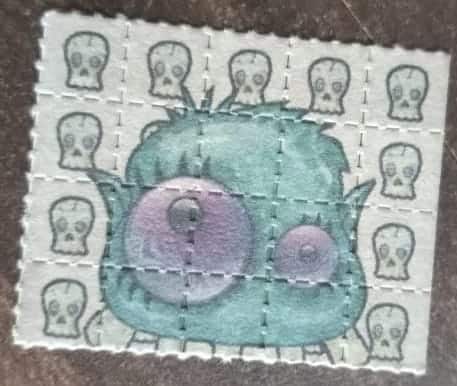“There has been a 20 percent increase in patients admitted for alcohol and drug abuse this year, as compared to 2007,” says Dr Poorna Chandrika, Deputy Superintendent, Institute of Mental Health.
“Alcohol and drug related crimes are on the rise in Chennai. In over 25 percent of criminal cases in Chennai, the offender was inebriated during or before the crime,” says V Kannadasan, a criminal lawyer, practising in Madras High Court.
The above data signify two things: one, the number of citizens falling prey to alcoholism and other substance abuse is clearly on the rise and that this may well have a close connection to crime rates in the city. But that is not all. According to officials of the Narcotics Control Bureau (NCB), Chennai has also witnessed a sharp rise in the use of club drugs such as LSD and cocaine in the recent past.

Narcotics Control Bureau seized half kilo of Methamphetamine at St thomas Mount, Chennai recently. Credits: NCB
Patterns of addiction
Alcohol addiction has long been a consuming problem in Chennai. But things changed in the 1980s, with the emergence of marijuana. “Using marijuana had been a social taboo for Chennaites (till then). People were not open about smoking pot back in the 1980s. It was mostly migrant students from North Indian states that introduced pot to Chennaites,” says K N S Varadan, a former substance addict, who now runs a de-addiction centre called Freedom Care.
Educational institutions such as IIT-Madras, Madras Christian College and SRM University are notorious for drug abuse. “During the annual festivals in IIT-Madras, we would spend days and nights smoking pot,” recollects Varadan.
The trend still continues, making marijuana the most widely abused substance in Chennai. “Naxals at the borders of Andhra Pradesh and Orissa grow marijuana illegally. There are groups that transport it regularly to Tamil Nadu and other parts of Andhra Pradesh,” says A Bruno, Zonal Director, NCB.
According to an alumnus of Madras Christian College and SRM University, the best part of studying in these colleges is that no one judges you for smoking pot. It is just considered a part of having fun; only a few get addicted.
The last decade, however, saw the emergence of high end drugs in the city. Party drugs such as LSD, known to be rampant in Goa, have now reached Chennai. The NCB surveillance team seized 20 blots of LSD stamps from the house of a person earlier this year. LSD blots, a party drug that resembles stamps, are slowly flooding Chennai, due to ease of transportation.
Then, there is rampant abuse of prescription drugs such as Codeine and Morphine, as the NCB seized about 2 lakh tablets and 100 syrup bottles last year, shared Bruno.
Age and gender-wise trend
| Age | Addictive substance | Salient factors at play |
| 12-15 years | Whiteners, nail polish removers, dry lizard’s tail | No knowledge about other drugs, fear to procure them etc |
| 16 -18 years | Cannabis | Seek help from peers and learn about peddlers |
| 18 -30 years | Hardcore drugs(Methamphetamine, and LSD) | Chances of getting caught at home/ work are less, compared to alcohol, peer pressure |
| Above 30 -50 years | Alcohol | Less dependency/ staying away from parents, work culture (office parties) |
| Above 50 years | Alcohol and Cannabis | Retirement stage to kill boredom |
(The data is procured after talking to eight psychiatrists and experts in de-addiction centres in Chennai)
“There has been an increase in the number of retired officials getting into rehabilitation centres. Most of them get into substance intake to pass time and don’t realise that they are getting addicted,” says Sunil Kumar of Mind Zone.
Among the female population, alcohol seems to be the most common addiction, followed by cannabis that is tried by a lot of college going girls. “But a lower percentage of female individuals become addicted (when compared with males). Social and family inhibitions stop women from regular inebriation,” says Varadan.
Three out of fifty people abuse substances not for fun, but to find solace, to get away from their social and personal issues, say experts. “There are people who can talk to other people only when they are drunk/stoned. What starts off as a means to cope with personal issues ends up taking a toll on the quality of lives,” says Dinesh Kumar, a psychologist.
Does addiction cut across socio-economic conditions? “While a rickshaw wala chooses to drink in a TASMAC outlet, a rich person would consume a branded liquor at a luxury bar. Likewise, cannabis that was once ‘socially unacceptable’ is now common among drivers, music directors, entrepreneurs and doctors. Mostly, people get addicted to the substances they start off with,” says Varadan.
State intervention and facilities
Despite the alarming rise in substance abuse in the city across classes and age groups, state support — in terms of both tackling the menace and rehabilitating the affected — remains far off the desired mark. Based on inputs from Dr V Sunil Kumar, clinical psychologist and K N S Varadan, founder of a de-addiction centre called Freedom Care, the overall scenario can be summed up thus, as far as state-provided care and facilities are concerned:
- Unlike foreign countries such as Singapore and the US, India has no policy to arrest a violent addict (usually from the streets) without a complaint and admit him in in-house rehabilitation centres legally.
- Under the scheme of assistance for the prevention of alcoholism and substance (drugs) abuse and for social defense services, the Ministry of Social Justice and Empowerment has established an Integrated Rehabilitation Centres for Addicts (IRCA) in every district. VHS hospital has one such centre in Chennai. However, considering the increasing incidence of addiction, and inadequate exclusive addiction treatment centres maintained by Tamil Nadu government (only one centre behind Royapettah hospital in Chennai), there should be more central government maintained centres.
- The Tamil Nadu government has psychiatric wards in the government hospitals like Stanley, Kilpauk Medical College Hospital and Rajiv Gandhi Government General Hospital and institutions such as Institute of Mental Health. However, these are not long term rehabilitation centres and don’t have exclusive facilities for addiction.
- The Mental Healthcare Act, 2017 gives no provision for involuntarily admitting an addict in rehabilitation centres. “Addicts cannot decide to get into rehab themselves. Voluntary admissions have good success rate, but there are addicts who cannot be convinced by counselling. That’s why the Act should be amended,” feels Varadan.
The solution
Legally, prohibition of alcohol across various countries have proved to be a failure, with people resorting to illicit liquor. “When it comes to alcohol addiction, the state government should set aside a big profit from TASMAC for rehabilitation. Closure of the shops doesn’t bring transformation,” says Anupriya Murugesan, a social worker.
However, when it comes to the usage of hardcore drugs, awareness and enforcement play a role. “Chennai was an open market for brown sugar from 1986 to 2000, with more than 20 peddlars selling the drug at Ice House, Chintadripet. But today, barely one or two peddlars exist, thanks to strict police action. The death of half of the peddlars due to addiction-related diseases helped many come out of the addiction,” said Varadan, adding that narrating such stories to the addicts is impactful.
The key to stay away from addiction is right parenting and family support, say psychologists and police personnel. “Law enforcement agencies are on the job. But the effective solution is to cut down the demand for drugs, which is only possible through behavioural change. People should willingly opt for an addiction-free lifestyle,” says A Bruno.
“One time treatment can slightly alter behaviour in the short term, but not reverse addiction. Just like a diabetes patient has to pay multiple visits to a diabetologist, addicts should also take sustained psychiatric support ” advises Varadan.

One way to prevent addiction is to curb inflow of drugs. But top enforcement officers are silenced with crores by gutkha dealers for example, nothing can be done. Easy money is the motto of higher enforcement officials whichever cadre they belong to. The avarice for crores must stop first. Now the perception is give crores; one can “run business with protection”. This status should change. HC also shields such officers, which is highly regrettable. HC provides excellent explanation not analysing the case but analysing why the case was filed which is tangential to the purpose of filing the case.
Like all her other articles , this is another EXCELLENT ARTICLE by Sr. reporter Ms Laasya Shekar. Clearly exposes a hidden and massive social problem in Chennai. The Corrupt Lawn ENFORCEMENT OFFICERs AND even those Senior and Junior Highly corrupt TN POLICE staff and Terribly corrupt TN Govt officers , Ministers etc – who all abet and involve in their Massive support to the Criminal Drug Mafia – should be publicly exposed with name and photos in ALL media and Trapped and arrested covertly via Media / Sting Operations to get rid of these “dirty society cockroaches” whos DELIBERATELY spread massive Filth and Illness and spoil the Mind, health, and career and even entire life of Young Children and YOUTH – due to their own HGIGHLY CORRUPT Mind and Massive Greed for EASY MOOLAH !!
It would definitely be a failure if the government decides to put a total ban on alcohol . Because this will make people turn to illicit liquor and arracks which are even more hazardous and the ban would also increase the dependence on hard drugs . So the only solution is not to pressurize anyone to such an extent where they feel to live in an Illusion . The government should better legalize alcohol and marijuana which has been proven to be better and medicinally beneficial . The government should also control the production and quality of marijuana and stop people from resorting to black markets of marijuana which sell adulterated marijuana that is potentially dangerous . These two amendments would definitely bring a change .
Good and Informative article. Thank you.
Well, the main key to every other problem is ‘ behaviour change ‘ not only one who has but includes others with dissimilar issue.